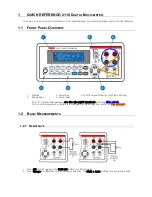
Signametrics
36
The more abrupt the signal, the less stable the measurement will be. Therefore a measurement of a square
wave will be noisier than that of a sine.
This function requires a repetitive signal. Connect the input signal between the
V+
and the
V-
terminals.
4.2 Current Measurements
The SMU2060 measures AC and DC currents between 100
A and 2.5 A. Use the +
I, 4W
terminals,
being certain to always leave all other terminals disconnected. Use the AC/DC button to switch between
AC and DC. The AC current is an AC coupled True RMS measurement function. See figure 4-2 for
connection.
The Current functions are protected with a 2.5 A, 250 V fuse internal to the DMM. The 2.4mA and 24mA
ranges utilize a 10
shunt, while the 240mA and 2.4A ranges use a 0.1
shunt. In addition to the shunt
resistors, there is some additional parasitic resistance in the current measurement path associated with the
fuse and the internal wiring. The maximum burden voltage is about 250mV.
4.2.1 Extended DC Current Measurements (SMU2064)
In addition to the 2.4mA, 24mA, 240mA and 2.4A, the SMU2064 has four additional ranges; 240nA,
2.4uA, 24uA and 240uA ranges. The lower three ranges are implemented with a “Virtual Zero Shunt”
technology, commonly associated with specialized Nanoameters. It has an ultra low noise low leakage
electronic shunt that renders it useful for measuring down to few Pico-amperes. This means that super
low currents from such circuits as Current output DACs, commonly found in implanted medical devices
such as heart pace makers and defibrillators, or low semiconductor leakages can be measured with
practically no voltage drop.
In order to measure down to Pico Amperes it may be necessary to guard the terminals as described in the
guarding section of this manual (4.3.8 Guarding High Value Resistance Measurements). It is also a good
idea to zero the measurement function using ‘Relative’ control.
Warning! Applying voltages greater than 35 V to the I+ and/or the I- terminals can cause personal
injury and/or damage to your DMM and computer! Think before applying any inputs to these
terminals!
4.2.2 Improving DC Current Measurements
When making sensitive DC current measurements disconnect all terminals not associated with the
measurement. Use the
Relative
function while in the desired DC current range to zero out any residual
error. Using the
S-Cal
(
DMMCalibrate ()
) prior to activating
Relative
will improve accuracy further.
Although the SMU2060 family is designed to withstand up-to 2.4A indefinitely, be aware that excessive
heat may be generated when measuring higher AC or DC currents. If allowed to rise this heat may
adversely effect subsequent measurements. In consideration with this effect, it is recommended that
whenever practical, higher current measurements be limited to short time intervals. The lower two ranges
of DC current may be effected by relay contamination. If the measurements seem unstable or high, while
in IDC measurement, apply between 20mA and 50mA DC to the current terminals and clean the K2 relay
using the
DMMCleanRelay(0, 2, 200)
. Repeat this until the measurements are stable.
4.2.3 DC Current Measurements at a specific voltage
The leakage measurement function can be used to measure low-level currents at a specific voltage. This
function uses the top and bottom terminals of the SMU2064. It measures low level DC currents with a
specified DC voltage applied to the DUT.
4.3 Resistance Measurements
The key to resistance measurements is the number of stable current sources available. The SMU2064
utilizes eight, and the SMU2060 has six stable current sources. The
V, 2
+
provides the positive
terminal and the
V, 2
-
negative terminal of this current source. The DMM measures resistance by
















































